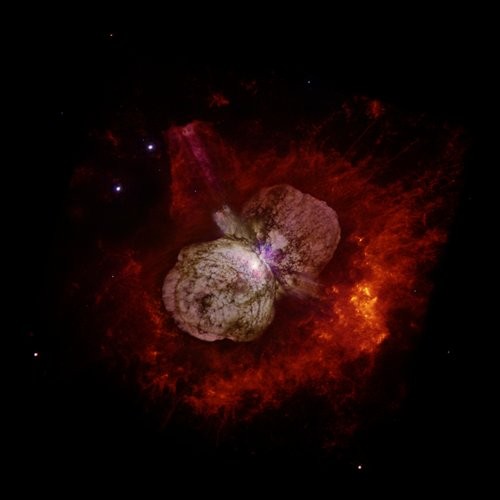NASA Releases 3D Models of Explosive Dual-Star Eta Carinae
| Marco Foronda | | Jan 09, 2015 07:04 AM EST |
(Photo : Wikipedia) A Hubble Space Telescope image showing Eta Carinae and the bipolar Homunculus Nebula that surrounds the star.
NASA observatories on Wednesday presented stunning new observations of the explosive dual-star system Eta Carinae at the American Astronomical Society's conference.
Astronomers used space telescopes, a supercomputer and a 3-D printer to see through the star system's dense nebula and record new observations.
Like Us on Facebook
A notable discovery was a set of luminous flares on the surface, which astronomers believe indicates Eta Carinae's changing stellar winds.
Thomas Madura of NASA mapped the stars' stellar winds clashing with each other using supercomputer simulations. The result was an improved demonstration of the dual-star system.
The team was also able to look deeply into the anatomy of Eta Carinae's center using 3-D models. Scientists have observed Eta Carinae since the 19th century, aware of the possibility it might explode in a great supernova.
Although recent observations couldn't determine when Eta Carinae will go nova, the recent findings made significant contributions to the study of the star system.
"We are coming to understand the present state and complex environment of this remarkable object," said Ted Gull, NASA's Goddard Space Flight Center astronomer. He added that they have a long way to go to forecast Eta Carinae's future behavior and explain past eruptions.
Scientists expect the stars to move closer again in 2020. When the stars encounter each other, they produce intense solar winds. When the winds collide, they heat the gas around them and cause X-ray emissions, said Michael Corcoran of Goddard.
Through this event, astronomers hope to gain new knowledge of the star system.
The Eta Carinae system consists of a primary star 90 times bigger than our Sun and a smaller star orbiting the other. The primary star erupted twice in the 1840s for reasons still unknown, transforming it into the brightest star close to Earth and causing the Homunculus Nebula to expand.
TagsNASA, Stars, Eta Carinae, Astronomy, stellar
©2015 Chinatopix All rights reserved. Do not reproduce without permission
EDITOR'S PICKS
-

Did the Trump administration just announce plans for a trade war with ‘hostile’ China and Russia?
-

US Senate passes Taiwan travel bill slammed by China
-

As Yan Sihong’s family grieves, here are other Chinese students who went missing abroad. Some have never been found
-

Beijing blasts Western critics who ‘smear China’ with the term sharp power
-

China Envoy Seeks to Defuse Tensions With U.S. as a Trade War Brews
-

Singapore's Deputy PM Provides Bitcoin Vote of Confidence Amid China's Blanket Bans
-

China warns investors over risks in overseas virtual currency trading
-

Chinese government most trustworthy: survey
-

Kashima Antlers On Course For Back-To-Back Titles
MOST POPULAR
LATEST NEWS
Zhou Yongkang: China's Former Security Chief Sentenced to Life in Prison

China's former Chief of the Ministry of Public Security, Zhou Yongkang, has been given a life sentence after he was found guilty of abusing his office, bribery and deliberately ... Full Article
TRENDING STORY

China Pork Prices Expected to Stabilize As The Supplies Recover

Elephone P9000 Smartphone is now on Sale on Amazon India

There's a Big Chance Cliffhangers Won't Still Be Resolved When Grey's Anatomy Season 13 Returns

Supreme Court Ruled on Samsung vs Apple Dispute for Patent Infringement

Microsoft Surface Pro 5 Rumors and Release Date: What is the Latest?










